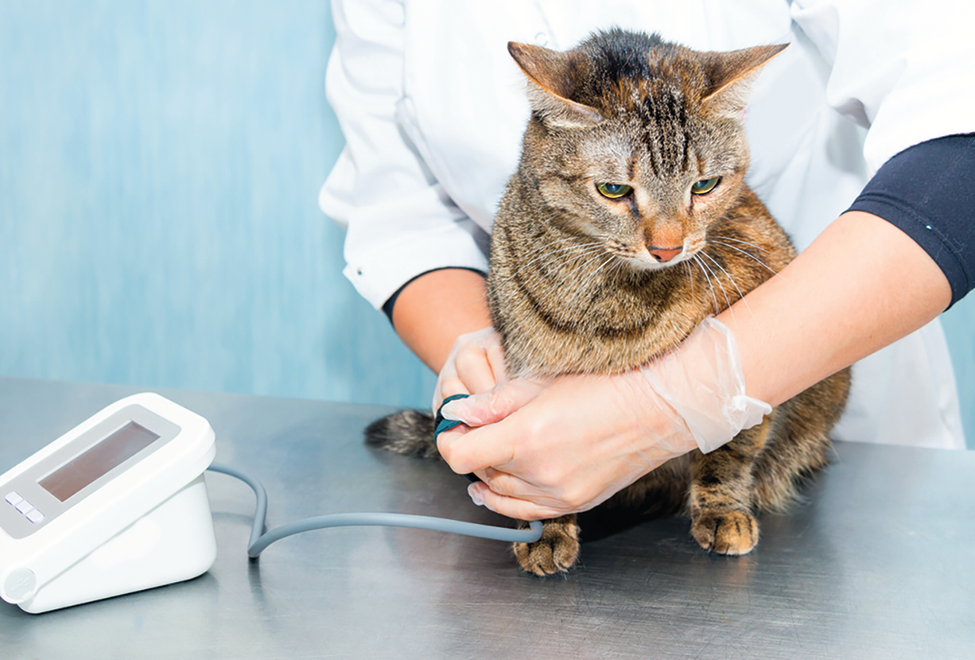Hypertension (high blood pressure) is as much a “silent killer” of cats as it is of people, so it pays to understand a little about this disease.
- Hypertension is systemic. It impacts the heart, kidneys, brain, and eyes. Your cat may be have trouble breathing, appear weak, or drag her rear legs. These may be signs of cardiac effects. From the renal standpoint, you may notice the litterbox is unusually wet. Her appetite might be off, and she may vomit. Seizures, disorientation, or unusual vocalization may reflect brain influence. The retina in the eye is sensitive to hypertension. Your cat may go blind without any warning.
2. Senior cats need regular screening. Senior cats (those 10 years of age and older) should have twice-annual physicals that include hypertension screening. Blood pressure is checked with an inflatable cuff placed around a leg. As the cuff deflates, pressure readings are provided by machines that detect when the blood flow that is initially blocked by the higher pressures of the inflated cuff becomes unblocked (the cuff pressure at which this occurs is considered the systolic blood pressure). Currently, the at-home versions to check your cat’s blood pressure are not considered accurate or reliable.
It’s not easy to get a cat settled for a blood pressure reading, but sometimes it helps to keep her in her carrier and remove the top half or open it up, so the veterinarian can have access.
Your veterinarian also will look for changes in the kidneys, brain, eyes, and heart. A screening blood chemistry panel will pick up renal effects. An ophthalmic exam may detect early changes related to hypertension. Cardiac effects may be suggested on auscultation and verified by echocardiography.
3. The kidney connection. Close to 80% of cats with hypertension show some signs of kidney disease, and 60% of cats with renal failure have high blood pressure. About a third of cats develop kidney disease, and the cause is often idiopathic (unknown). The kidneys filter toxins and wastes out of the blood and recover important nutrients and electrolytes. The first signs of kidney disease are often increased thirst and urination, weight loss, a lack of appetite, and lethargy. Some owners notice bad breath or drooling. Cats who aren’t feeling well may not groom themselves, so your cat may develop mats and lose that sleek coat. As waste products accumulate in the bloodstream, your cat may suffer from nausea and vomiting.
4. Hyperthyroidism is a possible cause. The connection between hypertension and hyperthyroidism—the overproduction of thyroid hormones—isn’t as clear as it is with kidney disease.
“The latest research shows that only about 10 to 25% of hyperthyroid cats have systemic hypertension, compared to older reports of 85% and up, but even that may be inflated by stress, because very few of the hypertensive hyperthyroid cats show evidence of target organ damage like retinal changes,” says Meredith Miller DVM DACVIM senior lecturer and section chief of Small Animal Medicine at Cornell University’s College of Veterinary Medicine. “For cats with both problems, hyperthyroidism usually comes first and leads to the cardiomyopathy (heart disease) and hypertension, especially with longstanding or poorly controlled disease,” she says.
Common signs of hyperthyroidism include weight loss, increased appetite, unkempt coat, increased drinking and urination, hyperactivity and/or increased aggression, vomiting, and changes in the cat’s voice.
5. Treat the cause, if known. In addition to hyperthyroidism and kidney disease, obesity, and hyperaldosteronism, an adrenal disorder, can contribute to high blood pressure.
With treatment, feline hypertension is frequently controllable and may be reversible if the underlying disease is successfully treated. However, 10 to 20% of cats have no obvious cause. It’s important to distinguish these cats from cats in which inaccurately high blood pressure readings are obtained due to stress. Most veterinarians will take two to three readings to see if calming down in the setting changes a reading.
Medications for Hypertension
For the hypertension itself, many veterinarians prescribe calcium channel blockers such as amlodipine (Norvasc), and angiotensin-converting enzymes, commonly called “ACE,” inhibitors, such as benazepril (Lotensin). Both drugs relax and dilate the blood vessels. For some cats, combining benazepril with amlodipine works well.
Amlodipine is a first-choice medication, with the best track record for use in cats. It works directly on smooth muscle in the vasculature and may drop readings as much as 30 to 60 millimeters of mercury (mmHg). The goal is to have a blood pressure reading of 160 mmHg or less to minimize organ damage. Amlodipine can be given both orally and transdermally (through the skin). Be aware that it may take time to get the ideal dose calibrated for your cat.
Telmisartan (Semintra) is the only FDA-approved treatment for hypertension in cats. This oral drug is an angiotensin receptor blocker that works on the renin-angiotensin-aldosterone system, which regulates blood volume.




